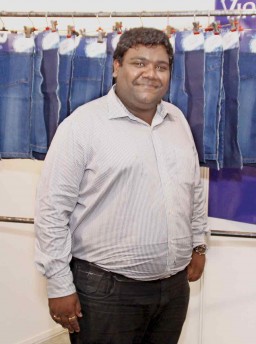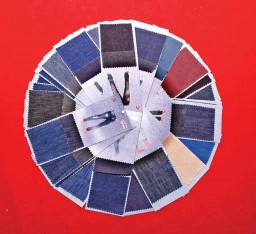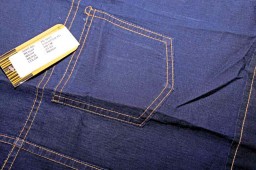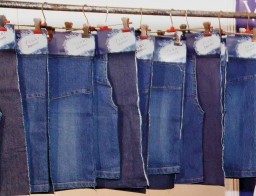
The strong demand of denim wear has been constantly and continuously fuelling capacity expansion in denim fabric with manufacturing capacities over the last few years growing multi-folds. As of today, India produces close to 800 million metres of denim fabric annually, which is expected to grow to 1.2 billion metres by 2015. Seeing great growth potential and innovative development in denim, Denim Club India organized a first ever two-day show – Indigo, recently in Noida.
Being a first time show, Indigo was not so big in terms of participation of denim fabric mills, though the companies that exhibited were leading ones. There were six Indian mills, namely LNJ Denim, Modern Denim, Chiripal, Suryalakshmi, Oswal Denim and fairly new entrant Vinod Denim. In the knitted denim category, AGC (A. Ganapathi Chettiar) from Tirupur participated in the show. From Pakistan SM Group and Pak Denim were there. The show was inaugurated by the Turkish Ambassador to India – HE Dr Burak Akcapar, though, disappointingly not a single Turkish denim company was spotted at the show. Majority of the exhibitors shared their view with Team Apparel Online that had the venue been at a central place in Delhi, the footfall could have been much higher.
Along with the exhibition, seminars were conducted in which speakers gave their perspectives about the global denim market along with the Indian market. According to Prashant Agarwal, Jt. Managing Director, Wazir Advisors, the denim industry needs to think strategy in two distinct segments; export and domestic segment, as the needs in both are very different. “The domestic market is huge and low-cost and it still needs to be tapped. Denim has the potential to penetrate deep into two- and three-tier towns where everybody would like to wear denim. I strongly feel that in the next 10 years, this industry will grow by 10 to 12 per cent every year,” predicts Prashant.
According to industry experts, in the export market there is still a surplus supply of denim and it shall remain like that, therefore there is and will always remain lesser margins. “In India, the mills are just focusing on producing fabrics and not converting that fabric into garments, whereas in Bangladesh whichever denim factory is coming up is not exporting fabric, rather they are exporting garments. However, in India there are very few conversion factories and most of them are not successful as they are not ready to setup economies of scale both in stitching and finishing capacities, hence Bangladesh will always be much more competent than India in denim exports,” opined Prashant.
However, the view has a counter theory, as the kind of capacities Indian denim mills are having and are building up, it’s not possible for the same mill to convert all its produce into garments. Secondly, the whole system of running a mill and a garmenting unit are two very different ball games. “Sometimes backward integration is much better than forward integration. If I have a production capacity of 20 lakh metres/month, to consume that kind of metreage what would be the size of garmenting unit? Secondly, fabric manufacturing is very skilled and it comes through years of experience. It took us eight years to master the weaving technology and we are now ready to get into more high-end value additions; if we divert our attention to garmenting which is totally a different scenario, then we cannot achieve the level of competency we want to achieve in producing value added denim fabrics,” avers P.G. Niyogi, CEO, Oswal Denims, Mohali.
With its seven years of existence, Oswal Denim is producing 36 million metres per annum from its Mohali and Bhopal units. The company is producing 85 per cent cotton/lycra denim and rest is poly lycra. In the next three months the company is going to add 12 lakh metres/month. “With the added capacity we are now looking at entering the export market through the RMG sector and not direct export of fabric, as the latter needs huge quantities,” says Niyogi.
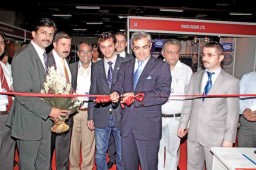
Most industry experts feel that India is today better positioned than other denim manufacturing countries. According to them, Indians have vision and know-how and their capabilities and acceptance by leading brands, private labels and stores worldwide is the proof of this proclamation. Expressing his views on India being one of the strongest players in denim, Kiran Panchal, President (Marketing), Modern Denim Ltd. says, “China has never been a threat to us as far as high-fashion denim fabrics are concerned; they were always into basics and now with their economy getting stronger, labour getting expensive, India would get much larger share.”
Sharing his view on the China impact, Vinod Mittal, Managing Director, Vinod Denim Ltd., Ahmedabad, a new player with about two years existence and producing 15 million metres/annum says, “Denim worldwide is growing by 20 per cent while other fabrics are growing by 15 per cent, Looking to move up the value chain, China has cut down its denim production by 30 per cent; leaving the field open to India, Turkey and Pakistan. Pakistan’s total production in denim would be lesser than what Ahmedabad alone is manufacturing, so undoubtedly India is the largest contributor in this 20 per cent growth.”
[bleft]The strong demand of denim wear has been constantly and continuously fuelling capacity expansion in denim fabric with manufacturing capacities over the last few years growing multi-folds.
In the export market there is still a surplus supply of denim and it shall remain like that, therefore there is and will always remain lesser margins.” [/bleft]
Talking about India’s strength in innovations and his company penetrating into more innovative products, Panchal Shares, “We want to change denim into functional and sustainable fabric. We have recently used 70 per cent bamboo and 30 per cent organic cotton to make eco-friendly, sustainable and biodegradable fabric with vegetable dyes both for knitted and woven applications.”
Besides this, Modern has also made face and back denim in which one side is denim and the other side is white. Both sides are 3/1 twill, so when a garment is made especially capri pants which has the bottom seam turned up and tint is given to it, it will have the colour effect. In another design idea printing can be done on the white side and bottom turned up. It can be used as reversible garment. Keeping the focus is on innovative weaves and also finishes, coating and lamination, the other innovative product by Modern Denim is knitted denim which has comfort and both way stretchability, which makes it very good feel. Also functional finishes and membrane breathable lamination adds to the functional value.
For rain and cold protection the company has developed denim laminated with denim fleece and transparent waterproof lamination using breathable membrane. The company has also developed wool denim for comfort in cold weather. Modern Denim with a turnover of Rs. 168 crore/annum has recently added its loomage capacity and as on date is producing 22 million metre/annum and will add more loomage to reach 30 million metres per annum by next year.
Dhaval Mittal, Director, Vinod Denim feels that the Indian market is too huge to be explored fully; however the two- and three-tier cities are the promising growth areas. “As of now we are not looking at exporting our fabric, the demand within India is huge. We are going for capacity expansion from 15 million metres, we’ll make it to 22 million metres/annum in another six months,” avers the young Dhaval who was the man behind introducing denim to his family business. “We entered into denim manufacturing in 2011 that time our turnover was Rs. 60 crore and now it has touched Rs. 90 crore; denim is going to be our focus area in coming times.”
[bleft]Denim worldwide is growing by 20 per cent while other fabrics are growing by 15 per cent. Looking to move up the value chain, China has cut down its denim production by 30 per cent, leaving the field open to India, Turkey and Pakistan. [/bleft]
Right now Vinod Denim is making the basic denim fabric as they are very new into the business of denim; however, as they established themselves more, they would like to go for more value-added fabrics. Producing poly cotton and cotton lycra, the company is catering to the mass market. “In about a year’s time when we are more established in the market, then we’ll start building our own R&D team and produce more specialized products,” shares Dhaval.
SM Denim from Pakistan attracted much interest. “There are about 28 denim mills in Pakistan; mainly the denim companies have rope dyeing but we have slasher dyeing,” shares Junaid Javed, Executive Director, SM Denim, Pakistan specialising in light weight fabrics from 4 ounce to 5 ½ ounce for shirting mainly for women. Catering to brands like Zara, H&M, Hugo Boss and the likes, SM Denim founded in 2002 is producing 12 million metres/annum and exporting its fabrics to Bangladesh, Europe, US, Sri Lanka, Vietnam. “We are looking at doubling our capacity as the demand is increasing especially with Bangladesh,” shares Junaid.
The event also saw many support industries share their offerings. Bureau Veritas Consumer Product Services showcased their capability in the arena of testing, audits, inspection and training for Denim and non Denim products. Pradip Bhattacharya covered the testing and compliance requirements of garments with special focus on denim apparels at the seminar. “Events like Indigo fulfil the primary objective of helping meet the needs of the fast-growing denim industry and a rapidly evolving denim-wear market by enabling all the stakeholders in the entire denim eco-system in coming together on a single platform for networking, exchanging ideas, sharing current experiences and with a vision for the future,” concluded Pradip.





